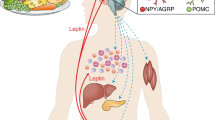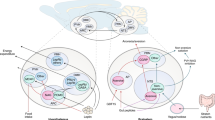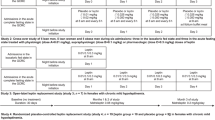Abstract
Leptin is an adipocyte hormone that functions as an afferent signal in a negative feedback loop regulating body weight1,2,3,4, and acts by interacting with a receptor in the hypothalamus and other tissues5,6. Leptin treatment has potent effects on lipid metabolism, and leads to a large, specific reduction of adipose tissue mass after several days1,4. Here we show that leptin also acts acutely to increase glucose metabolism, although studies of leptin's effect on glucose metabolism have typically been confounded by the weight-reducing actions of leptin treatment, which by itself could affect glucose homoeostasis1,2,3. We have demonstrated acute in vivo effects of intravenous and intracerebroventricular administrations of leptin on glucose metabolism. A five-hour intravenous infusion of leptin into wild-type mice increased glucose turnover and glucose uptake, but decreased hepatic glycogen content. The plasma levels of insulin and glucose did not change. Similar effects were observed after both intravenous and intracerebroventricular infusion of leptin, suggesting that effects of leptin on glucose metabolism are mediated by the central nervous system (CNS). These data indicate that leptin induces a complex metabolic response with effects on glucose as well as lipid metabolism. This response is unique to leptin, which suggests that new efferent signals emanate from the CNS after leptin treatment.
This is a preview of subscription content, access via your institution
Access options
Subscribe to this journal
Receive 51 print issues and online access
$199.00 per year
only $3.90 per issue
Buy this article
- Purchase on Springer Link
- Instant access to full article PDF
Prices may be subject to local taxes which are calculated during checkout



Similar content being viewed by others
References
Halaas, J. L. et al. Weight-reducing effects of the plasma protein encoded by the obese gene. Science 269, 543–546 (1995).
Campfield, L. A., Smith, F. J., Guisez, Y., Devos, R. & Burn, P. Recombinant mouse OB protein: evidence for a peripheral signal linking adiposity and central neural networks. Science 269, 546–549 (1995).
Pelleymounter, M. A. et al. Effects of the obese gene product on body weight regulation in ob/ob mice. Science 269, 540–543 (1995).
Halaas, J. L. et al. Physiological response to long-term peripheral and central leptin infusion in lean and obese mice. Proc. Natl Acad. Sci. USA 94, 8878–8883 (1997).
Tartaglia, L. A.. et al. Identification and expression cloning of a leptin receptor, OB-R. Cell 83, 1263–1271 (1995).
Lee, G. H. et al. Abnormal splicing of the leptin receptor in diabetic mice. Nature 379, 632–635 (1996).
Levin, N., Nelson, C., Gurney, A., Vanelen, R. & De Sauvage, F. Decreased food intake does not completely account for adiposity reduction after ob protein infusion. Proc. Natl Acad. Sci. USA 93, 1726–1730 (1996).
Cohen, B., Novick, D. & Rubinstein, M. Modulation of insulin activities by leptin. Science 274, 1185–1188 (1996).
Saladin, T. et al. Transient increase in obese gene expression after food intake or insulin administration. Science 377, 527–529 (1995).
Mercer, J. G. et al. Localization of leptin receptor mRNA and the long form splice variant (Ob-R) in mouse hypothalamus and adjacent brain regions by in situ hybridization. FEBS Lett. 387, 113–116 (1996).
Golden, P. L., Maccagnan, T. J. & Pardridge, W. M. Human blood-brain barrier leptin receptor. J. Clin. Invest. 99, 14–18 (1997).
Maffei, M. et al. Increased expression in adipocytes of ob RNA in mice with lesions of the hypothalamus and with mutations at the db locus. Proc. Natl Acad. Sci. USA 92, 6957–6960 (1995).
Satoh, N. et al. Pathophysiological significance of the obese gene product, leptin, in ventromedial hypothalamus (VMH)-lesioned rats: evidence for loss of its satiety effect in VMH-lesioned rats. Endocrinology 138, 947–954 (1997).
Fei, H. et al. Anatomic localization of alternatively spliced leptin receptors (Ob-R) in mouse brain and other tissues. Proc. Natl Acad. Sci. USA 94, 7001–7005 (1997).
Vaisse, C. et al. Leptin activation of Stat3 in the hypothalamus of wild type and ob/ob mice but not db/db mice. Nature Genet. 14, 95–97 (1996).
Schwartz, M. W., Seeley, R. J., Campfield, L. A., Burn, P. & Baskin, D. G. Identification of targets of leptin action in rat hypothalamus. J. Clin. Invest. 98, 1101–1106 (1996).
Caro, J. F. et al. Decreased cerebrospinal-fluid/serum leptin ratio in obesity: a possible mechanism for leptin resistance. Lancet 348, 159–161 (1996).
Miles, P. D. G., Yamatani, K., Lickley, H. L. A. & Vranic, M. Mechanism of glucoregulatory responses to stress and their deficiency in diabetes. Proc. Natl Acad. Sci. USA 88, 1296–1300 (1991).
Leong, S. F. & Clark, J. B. Regional enzyme development in rat brain: Enzymes associated with glucose utilization. Biochemistry 218, 131–138 (1984).
Lautala, P. & Martin, J. M. Glucose metabolism in rat hypothalamus. Acta Endocrinol. 98, 481–487 (1981).
Nagai, K., Fujii, T., Inoue, S., Takamura, Y. & Nakagawa, H. Electrical stimulation of the suprachiasmatic nucleus of the hypothalamus causes hyperglycemia. Hormone Metab. Res. 20, 37–39 (1988).
Collins, S. et al. Role of Leptin in fat regulation. Nature 380, 677 (1996).
Vranic, M., Kawamori, R., Pek, S., Kovacevic, N. & Wrenshall, G. A. The essentiality of insulin and the role of glucagon in regulating glucose utilization and production during strenuous exercise in dogs. J. Clin. Invest. 57, 245–255 (1976).
Gosteli-Peter, M. A., Schmid, C. & Zapf, J. Triiodothyronine increases glucose transporter isotype 4 mRNA expression, glucose transport, and glycogen synthesis in adult rat cardiomyocytes in long-term culture. Biochem. Biophys. Res. Commun. 221, 521–524 (1996).
Weinstein, S. P., O'Boyle, E. & Haber, R. S. Thyroid hormone increases basal and insulin-stimulated glucose transport in skeletal muscle. The role of GLUT4 glucose transporter expression. Diabetes 43, 1185–1189 (1994).
Ahima, R. S. et al. Role of leptin in the neuroendocrine response to fasting. Nature 382, 250–252 (1996).
Somogyi, M. Determination of blood sugar. J. Biol. Chem. 160, 69–73 (1945).
Tsao, T. S., Burcelin, R., Katz, E. B., Huang, L. & Charron, M. J. Enhanced insulin action due to targeted GLUT4 overexpression exclusively in muscle. Diabetes 45, 28–36 (1996).
Massillon, D., Barzilai, N., Hawkins, M., Prus-Wertherimer, D. & Rossetti, L. Quantitation of hepatic glucose fluxes and pathways of hepatic glycogen synthesis in conscious mice. Am. J. Physiol. 269, E1037–E1043 (1995).
Acknowledgements
We thank E. B. Katz, C. Vaisse, J. Li and T. S. Tsao for discussions; J. Blaire-West and D. A. Denton for help with the ICV surgery; S. Korres for helping to prepare the manuscript; and Amgen for recombinant leptin. This work was supported by grants from the NIH (J.M.F. and M.J.C.), Pew Charitable Trust (M.J.C.), Juvenile Diabetes Foundation International (R.B.), the Philippe Foundation (R.B.) and the Manpei Suzuki Diabetes Foundation (S.K.).
Author information
Authors and Affiliations
Corresponding author
Rights and permissions
About this article
Cite this article
Kamohara, S., Burcelin, R., Halaas, J. et al. Acute stimulation of glucose metabolism in mice by leptin treatment. Nature 389, 374–377 (1997). https://doi.org/10.1038/38717
Received:
Accepted:
Issue Date:
DOI: https://doi.org/10.1038/38717
This article is cited by
-
Regulatory Basis of Adipokines Leptin and Adiponectin in Epilepsy: from Signaling Pathways to Glucose Metabolism
Neurochemical Research (2023)
-
Prostaglandin in the ventromedial hypothalamus regulates peripheral glucose metabolism
Nature Communications (2021)
-
Leptin brain entry via a tanycytic LepR–EGFR shuttle controls lipid metabolism and pancreas function
Nature Metabolism (2021)
-
Egr1 loss-of-function promotes beige adipocyte differentiation and activation specifically in inguinal subcutaneous white adipose tissue
Scientific Reports (2020)
-
CNS Regulation of Glucose Homeostasis: Role of the Leptin-Melanocortin System
Current Diabetes Reports (2020)
Comments
By submitting a comment you agree to abide by our Terms and Community Guidelines. If you find something abusive or that does not comply with our terms or guidelines please flag it as inappropriate.



